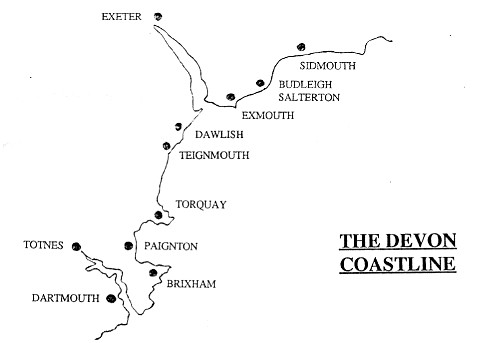
During the course of each year I get quite a number of requests for information on shell collecting in the West Country. Many of these requests come from America from collectors coming to this country on holiday. I have collected many years in this part of the United Kingdom and I suppose most, or say 80% of my British collection comes from this part of the coast. Most marine habitats are found here so I will deal with the area between Budleigh Salterton and Paignton. Budleigh Salterton is not very good as most of the beach is is large round pebbles. At the eastern end of the beach is a stream running into the sea, and a little further along a ridge of flat rocks with sand pockets between them. The usual rock dwellers can be found on the rocks and in rock crevices, but in the sand pockets we found quite a number of Dosinia exoleta, Linne 1758 , deep in the sand. During some visits a large amount of seaweed was being washed in. Examining this weed, a lot of which was the Laminaria group of weeds, we found a lot of Blue-rayed limpets, Helcion pelucida, Linne 1758 attached to it.
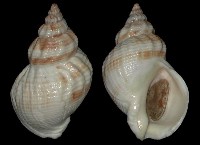
Going further west the next good shelling beach is Exmouth, on the north coast of the river Exe. This is an excellent beach with sand down to mid tide, and then at low tide weed covered sandstone rocks with deep gullies in between. These sandstone rocks are home to Zirfaea crispata, Linne 1758, Pholas dactylus, Linne 1758, Hiatella arctica, Linne 1758 and Venerupis saxatalis, Fleuriau,1802 in rock crevices. Between the crevices in the rocks low down near the waters edge can be found live Buccinum undatum, Linne 1758 , Nassarius reticulatus, Linne 1758, Mytilus edulis, Linne 1758 .These weed covered rocks need going through with a sieve as many small shells can be found. On the east side of the beach when the tide is coming in, Spisula solida, Linne 1758 can be found in vast numbers, as with Tellina tenuis,, DaCosta 1778, Venerupis pullastra, Linne 1758 and others.
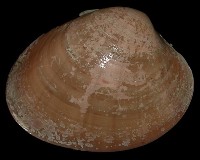
Going to the other side of the Estuary of the River Exe you will find the sandflats of Dawlish Warren. At low tide vast areas of sand are uncovered with deep pools between the sand dunes. On the western side at Dawlish there are rocks, and from there walking east you have 2-3 miles of sand, muddy sand, sand with rocks embedded in it. You can walk up to Starcross but here you have to be careful as the water qets very deep and the sand is treacherous. Many species are brought in by the currents, and in this area if you are lucky some very large Callista chione, Linne 1758 are washed in. Some valves up to 12cm. They are usually separated valves but you can sometimes get one which is complete from the fishing boats. Other shells to look for are the Paignton cockle, Acanthocardia aculetata, Linne 1758, Acanthocardia echinata, Linne 1758 and Acanthocardia tuberculata, Linne 1758. Cerastoderma edule, Linne 1758 is common on the sandflats. Other shells to look for are Gari tervensis, Gmelin 1791, Gari depressa, Pennant 1777 ( rare ) Tellina squalida, Montagu, Tellina tabula, Gmelin 1791, Spisula elliptica, Brown and Spisula subtruncata, DaCosta 1778.
Moving on from Dawlish the next place to stop is Teignmouth. Teignmouth is another place on a river estuary, the River Teign. On one side is Teignmouth and on the side is Shaldon. Teignmouth has a small harbour and many shells are washed up by the strong currents as the tide goes out. Again Spisula solida, Linne is very common. Also Clathrus clathrus, Linne 1758 can be found where a sandbar stretches out into deep water. Turritella communis, Risso 1826 is common near where the river runs out into the sea. On Shaldon side you can wade out on to the mudflats at low tide and dig out Venerupis decussata, Linne 1758 and Scrobicularia plana, DaCosta 1778. Further up the river mouth Modiolus modiolus, Linne 1758 and Nassarius incrassatus, Strom 1768 can be found.
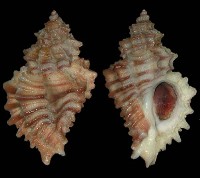
Between Teignmouth and Torquay there are rocky coves which have the usual rock dwellers plus the West Country Monodonta lineata, DaCosta 1778 which is very common in most coves. From the Torquay area the next stop, and the most prolific, heading west is the Paignton area, with Preston sands at the east end of Paignton Bay the best. It is a bay which sweeps round to Paignton harbour and consists of clean yellow sand with rocks at the east end. These weed covered rocks are exposed at low tide and usually have a wealth of shells among the weed and under rock shelves, but they are very slippery so care has to be taken. This area is unique because the varieties seem to change each year. One year there were masses of Natica catena, DaCosta 1778 coming in with the tide, another year Ocenebra erinacea, Linne 1758 feeding on the rocks in large numbers. Another year Calliostoma zizyphinum, Linne 1758 in many different colours were in abundance. Also both species of Trivia can be found among the weed. The sandy bay Itself produces many bivalves and is well known for the Acanthocardia aculeata, Linne 1758 and A.tuberculata, Linne 1758 which during rough weather come ashore in fair numbers.
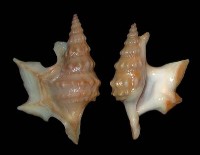
In the 1990's, this bay produced one of the most spectacular sights a shell collector could wish for During the Sunday of that week we had heavy thunderstorms in the Channel. We travelled down on Monday and on Tuesday decided to go to Preston Sands. On arriving and going down to the sands we were met by a sight which I doubt if we shall ever see again. The eastern end of the bay was covered to a depth of two feet or more with weed, fish, crabs, shells and other debris. It was an incredible sight. Lutraria lutraria would have filled several sacks. We found about three dozen Acanthocardia aculeata, Linne 1758, 3 specimens with very long spines and never found by me before. Acanthocardia tuberculata and Acanthocardia echinata were very common and there must have been dozens of them. Other specimens included Clausinella faciata, DaCosta 1778, Mysia undata, Pennant 1777, Scaphander lignarius, Linne 1758, Dosina lupinus, Linne 1758, Chlamys opercularis, Linne 1758, Pecten maxima, Linne 1758, Aporrhais pespelecani, Linne 1758, Venus striatula, DaCosta 1778, Cochlodesma praetenue, Pultenue, Thracia convexa, Wood 1828 and many hundreds of the more common shells. All these shells were either still alive or fresh dead. We spent three days going through this debris and by then the sea had washed away what was left.
We still don't know what caused this but it was an incredible sight and a sheller's dream. This is a brief account of what this area offers to a shell collector. The best time to go is either in the winter or early spring before the crowds get down there
I have included a list of most of the species collected which includes common shells and tiny shells not mentioned here. Good shelling to those who go.
This article was contributed by the late Geoff Cox to our Pallidula magazine in 1995 We would like to thank Lowtide Shells specialists in Atlantic shells for the use of their pictures(copyright)
Bivalves Acanthocardia echinatum, Linne, 1758 Acanthocardla aculeata, Linne, 1758 Acanthocardia tuberculata,. Linne,1758. Cerastoderma edule, Linne, 1758. Pavicardium exiguum Gmelin,1791. Pavicardium minimum, Philippi. Modiolus barbatus, Linne,1758 Modlolus adriatlcus, Lamarck, 1819. Modlolus modlolus, Linne, 1758. Mytilis edulis, Linne, 1758. Tellina Squlida, Montagu, 1803 Tellina tenuis, DaCosta, 1778. Fabulina fabula, Gmelln, 1791. Macoma balthica, Linne, 1758. Scrobicularia plana, DaCosta, 1778. Abra alba, W Wood, 1802. Gari fervensis, Gmelin, 1791. (dead.) Gari fervensls, Gmelln, 1791. (alive) Gari depressa, Pennant, 1777. Nuculana minuta, Muller, 1776. Glycymeris glycymeris, Linne, 1758. Anomia ephippium, Linne, 1758. Ostrea edulis, Linne, 1758. Crassostrea angulata, Lamarck,1819. Chlamys opercularis, Linne, 1758. Pecten maximus, Linne, 1758. Laevicardium crassum, Gmelin, 1791. Dosinia axoleta, Linne, 1758. Dosinia lupinus, Linne, 1758. Callista chione, Linne, 1758. Timoclea ovata, Pennant, 1777. Clausinella fasciata, DaCosta, 1778. Chamela striatula, DaCosta, 1778. Venerupis pullastra, Montagu, 1803. Venerupis saxatilis, Fleuriau, 1802. Venerupis decussata, Linne, 1758. Venerupis aurea, Gmelin, 1791. Irus irus, Linne, 1758. Mysia undata, Pennant, 1777. Donax vittatus, DaCosta, 1778. Cuttellus pellucidus, Pennant, 1777. Ensis ensis, Linne, 1758. Ensis arcuatus, Jeffreys, 1865. Ensis siliqua, Linne, 1758. Solen marginatus, Montagu, 1803. Mactra corallina, Linne, 1758. Spisula solida, Linne, 1758. Spisula elliptica, Brown, 1827. Spisula subtruncata, DaCosta, 1778. Lutraria lutraria, Linne, 1758. Lutraria magna, DaCosta, 1778 Lutraria angustior, Philippi, 1844. Mya truncata, Linne, 1758. Hiatella arctica, Linne, 1767. Pholas dactylus, Linne, 1758. Zirfaea crispata, Linne, 1758. |
Thracia phaseolina, Lamarck, 1818. Thracia pubescens, Montagu, 1803. Thracia conyexa , W Wood , 1815. Tellina pygmaea, Loven, 1846. Nototeredo norvagicus, Spengler, 1792. Philine quadripartita, Ascanius, Corbula gibba, Olivi, 1792. Psammobella tellinella, Lamarck, 1818. Arcopagia crassa, Pennant, 1777. Gafrarium minimum, Montagu, 1803. Gastropods Emarginula reticulata, Lamarck, 1801. Diordora apertura, Montagu, 1803. Patella vulgata, Linne, 1758. Patella aspera,. Roding, 1798. Helcion pellucidum, Linne, 1758. Calliostoma zizyphinum, Linne. 1758. Jujubinus exasperatus, Pennant. 1777. Jujubinus striatus, Linne, 1758. Monodonta lineata, DaCosta, 1778. Gibbula magus, Linne, 1758. Gibbula cineraria, Linne, 1758. Gibbula umbilicalis, DaCosta, 1758. Tricolia pullus, Linne, 1758. Lacuna v1ncta, Montagu, 1803. Lacuna pallidula, DaCosta, 1778. Littorina littorea, Linne, 1758. Littorina saxatilis, Olivi, 1792. Littorins neritoides, Linne, 1758. Littorina obtusata, Linne, 1758. Patelloida virginea, Muller, 1776. Turritella communis, Risso, 1826. Buccinum undatum, Linne, 1758. Bittium reticulatum, DaCosta, 1779. Clathrus clathrus, Linne, 1758 Clathrus turtonis, Turton, 1819. Aporrhais pes-pelacani, Linne. 1758. Crepidula fornicata, Linne, 1758. Natica catena, DaCosta, 1779. Natica poliana, Chiaje, 1826. Erato voluta, Montagu, 1803. Trivia monacha, DaCosta, 1778. Trivia artica, Montagu, 1803. Nucella lapillus, Linne, 1758. Ocenebra erinacea, Linne,. 1758. Nassarius reticulatus, Linne, 1758. Nassarius incrassatus, Strom, 1768. Cantharirus montagui, W Woods, 1828 Philbertia gracilis, Montagu, 1803. Bela nebula, Montagu, 1803. Chrysallida spiralis, DaCosta, 1777 Philine quadripartita, Arcanius, Cylichna cylindracea, Pennant, I777. Gingula semicostata, Montagu, 1803. Musculus discors, Linne, 1758. Hydrobia ulvae, Pennant, 1777. |
This web page was last updated on 15 September 2003 Copyright of all images remains with the originator and the British Shell Collectors Club and may not be copied without their expressed permission Copyrightę 2003 British Shell Collectors' Club All rights reserved.